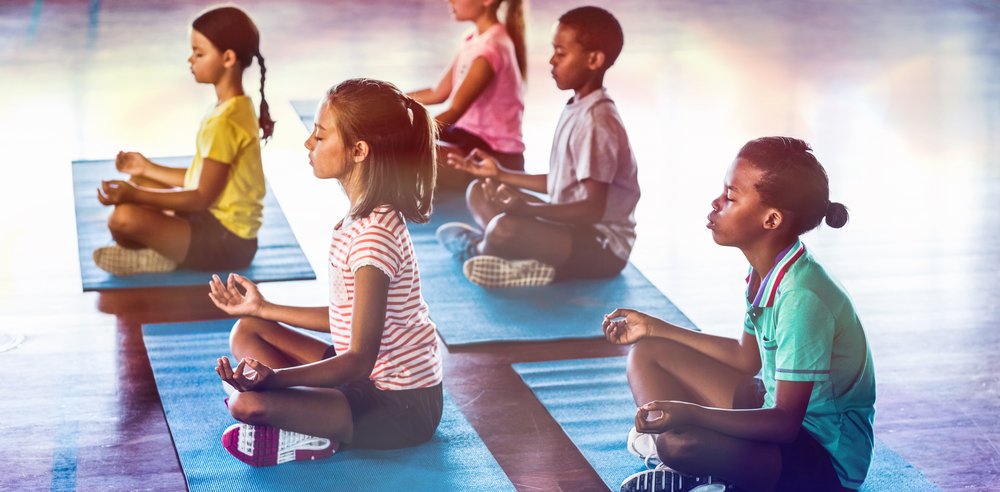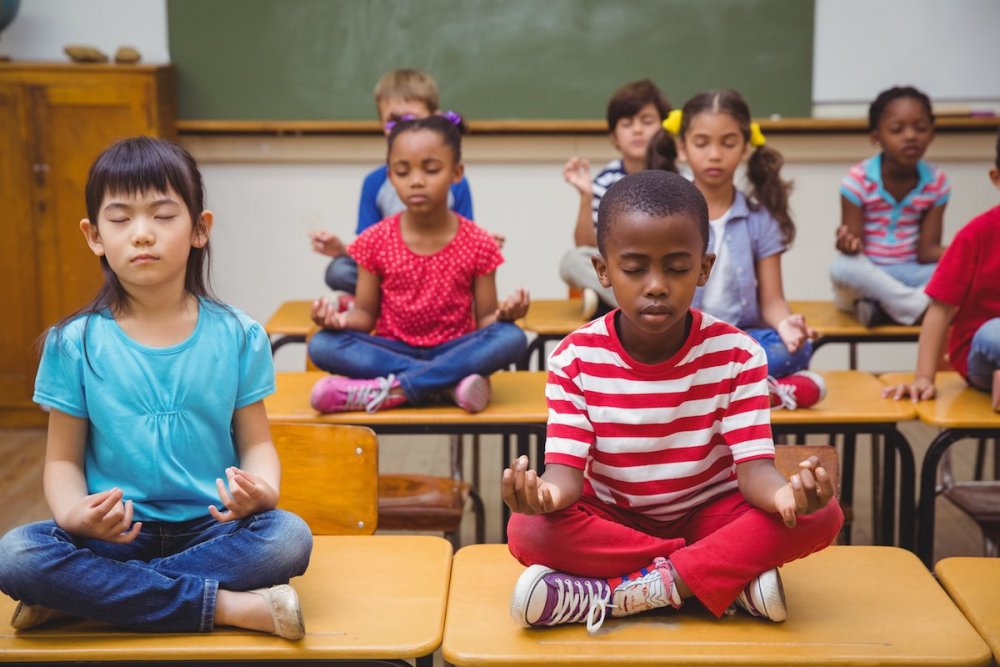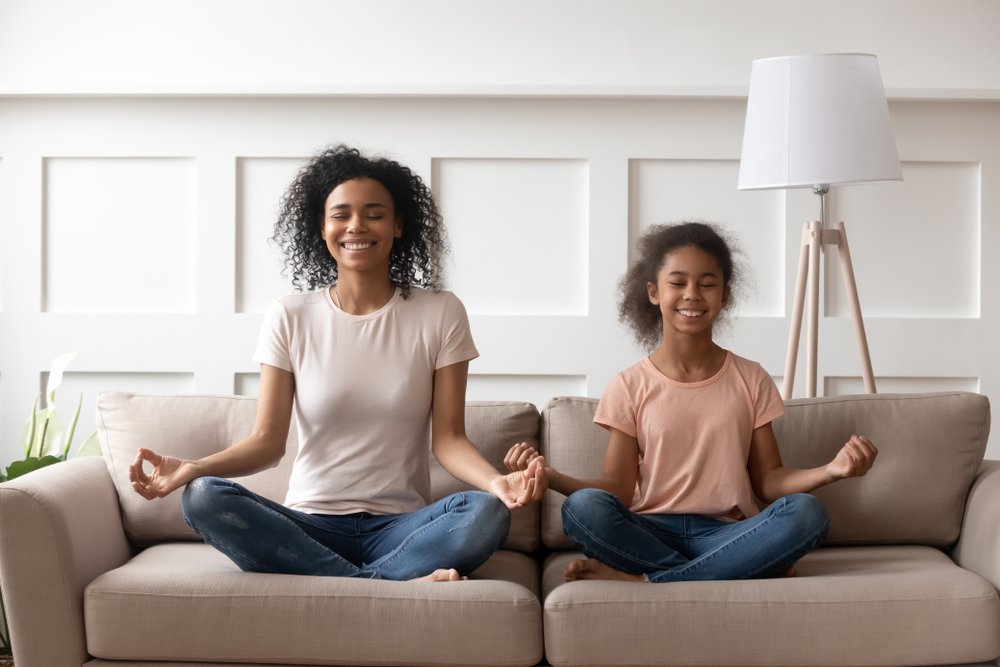Meditation and mindfulness are becoming increasingly popular for kids, with schools incorporating them into classes. Meditation practitioner Ann Vrlak looks at the benefits for children and explains three great meditation techniques you can practise with your own kids.
Have you noticed that meditation and mindfulness courses for kids are starting to pop up everywhere? In schools and in programs devoted to children?
In the same way meditation for adults has seen an explosion in the West over the last 30 years, educators and psychologists are now sending a clear message: meditation for kids is a powerful life skill. And when children learn mindfulness at a young age, we can plant seeds that grow and bear fruit throughout their whole life.
What is meditation?
There are so many styles of meditation it can sometimes be confusing. But meditation for kids can be put into two basic categories: mindfulness and imagination.
The definition of mindfulness I like to use teaching kids is this: paying attention to the present moment, right now, with kindness and curiosity. I explain all the terms in ways they can easily understand: “paying attention,” “right now” and, most importantly, “with kindness and curiosity.” There’s a lot in that simple definition for kids to understand and to practice.

Meditation for kids is a powerful life tool shutterstock/vectorfusionart
There are many mindfulness-based practices for kids, many of which use the senses and the breath, to help them explore this definition of mindfulness.
And imagination-based meditations use kids’ amazing power of imagination to take journeys into their body, to relaxing places or to experience different qualities like the strength and safety of the Earth. I’ll take you through an imagination exercise on grounding in the earth later in this article. Kids are very good – usually much better than adults – at really feeling what they imagine, taking in those qualities and making them their own.
Why are schools integrating meditation?
Ideally, schools are places where kids learn a lot about life: about different subjects from math to art; about achievement and evaluation; about friendship, peer pressure and conflict – and much more.
RELATED: 7 of the best mindfulness books for kids
And it’s not news that these things can be stressful for people of any age. It’s sobering to know that more kids than ever are experiencing anxiety and depression. According to the CDC, in the USA, 7 per cent of children aged between three and 17 have diagnosed anxiety (approximately 4.4 million kids), and just over 3 per cent in the same age range (approximately 1.9 million) have diagnosed depression. Research shows that at younger and younger ages, children are feeling the pressure to excel at school or to be accepted by schoolmates.
So, schools are an ideal place to introduce meditation for kids. They can learn how meditation can help them cope with life challenges. There are two key reasons that meditation has become a favourite tool to build these kinds of skills.
“Meditation for kids is a powerful life skill. And when children learn mindfulness at a young age, we can plant seeds that grow and bear fruit throughout their whole life.”
Firstly, because over the past few decades researchers have become very interested in studying meditation in general and for kids in particular. We have many studies now that show the proven psychological, emotional and physical benefits of meditation.
There's one school in the US – Patterson High School in Baltimore – that is successfully using meditation as a “time out” activity for kids if they're acting out. Called the Mindful Moment Program, this innovative idea gives kids the skills to be with themselves and calm down through meditation and yoga – and with great results. Since launching the program, suspensions for fighting have dropped, and both attendance figures and the average GPA of first time ninth graders has increased.
Secondly, meditation for kids has become so valued because of the wide and varied range of those benefits. Here are just some of the strengths and skills kids can build when they practice simple, non-religious meditation practices. They have been shown to:
1. Foster self-compassion and compassion for others
Remember the definition of mindfulness earlier in this article? The part about kindness and curiosity? Observing yourself, and others, with kindness (rather than criticism or judgement) builds a caring relationship with yourself and empathy for others.
2. Improve focus and concentration
Many meditation for kids exercises involve paying attention to something in particular and learning what to do when your mind wanders from your task.
3. Reduce stress, anxiety and depression
Meditation exercises that show kids how to connect with their bodies, breath and senses calm their nervous system. They learn how to trigger this physiological healing and, again, to treat themselves with kindness while they practice and sometimes experience difficult emotions.

Meditation in schools is proving successful for kids
4. Help kids make better decisions
When kids are more calm and focused, and practicing self-care, they’re better able to make good choices.
5. Enhance creativity
Meditation activates and integrates many areas of the brain. Creativity is powered up!
6. Self-regulate their emotions and behavior
There are meditation exercises specifically for handling tough emotions, like sadness or anger or frustration. Kids can learn powerful ways have their emotions, rather than their emotions having them.
Teaching meditation to your child at home
Whether or not your child’s school has meditation or mindfulness programs, you can teach them meditation at home. And one of the great things is that you will also benefit from the practice. Indeed, it’s a great way to learn together, share experiences and strengthen your relationship with your children.
“Schools are an ideal place to introduce meditation for kids. They can learn how meditation can help them cope with life challenges.”
So, what do meditation practices for kids look like? Here are a few simple ones you can try – two mindfulness based and one imagination-based. Try them yourself a few times before you teach them. Keep the practices short – about one minute per year of age: five minute exercises with five year olds, and so on.
And keep these things in mind for all the exercises:
- To begin, find a comfortable position either sitting up or lying down. Take a couple of deep relaxing breaths.
- When your mind wanders away from the particular exercise, that’s totally fine. That’s what your mind does! Just bring it back gently to the exercise.
- Know these exercises have two basic purposes: to help kids strengthen their attention and to guide them toward a particular positive experience.
- Ask them about their experiences and share what you experienced, too.
Mindfulness-based exercises
1. Swing with your breath
Paying attention to the breath is a great way to soothe the nervous system and bring some calm.
- Start paying attention to your breath in your chest. Feel your chest moving up and down.
- And feel how the movement of your breath is like being on a swing. There’s an upswing and a slight pause, then the downswing and a slight pause. Then the movement starts again.
- The goal of the exercise is to pay attention to and feel this whole movement – including the small quiet pauses – for as long as you can.
- Staying close to physical sensations helps kids relax and feel grounded in their bodies.

Practising meditation at home is a great way to connect with your kids shutterstock/fizkes
2. Sounds and silence
This is an example of a meditation exercise that uses kids’ sense of sound. Sensory-based practices are a great way for them to become present and calm.
- For this exercise, you'll need some sort of chime or bell. If you don’t have one, you can experiment with a glass or bowl that makes a ringing sound when you hit it with a spoon, for example. The sound should last 10 seconds or more.
- Tell your child that the purpose of the exercise is to listen to the whole sound – from the time you strike the chime until the sound disappears into silence. And when they can’t hear the sound, they raise their hand.
- Repeat this several times.
- You can quietly ask your child questions before each chime. “See if you can hear the sound even longer this time.” Or, “What do you hear after the sound is gone?”
Imagination-based exercise
1. Your grounding cord
In this exercise, kids imagine being connected to the whole planet earth, and all the strength and safety that brings. This exercise is done best in a sitting position, on the floor or on a chair.
- Guide your child to feel their tailbone and where it meets the floor or chair.
- Ask them to imagine a cord going from the tip of their tailbone down into the earth.
- Start at about five feet and progressively go deeper and deeper, until their grounding cord goes right to the centre of the earth.
- As you go, guide the child to feel the solidity and safety of the Earth, and how they are connected to all that strength through their cord.
- Use your imagination, too! Create a journey of exploration about the qualities of the earth and the child’s ability to really feel them.
- To finish, bring the grounding cord slowly up again, right up to your child’s tailbone. Ask them to enjoy how they feel and, if they like, to describe it to you. For example, how their body felt, what they saw or heard – leave the door open to hear their experience. It will help them to imprint the experience.
Takeaway: meditation for kids
We’re living in a wonderful time for meditation for kids. There are many programs and resources online and maybe even in your community that offer ways to bring meditation into your lives. I’ve given you a few links to explore at the bottom of this article. Plant the seeds of meditation for your child and watch them take root. ●
Main image: shutterstock/wavebreakmedia
Written by Ann Vrlak
 Ann Vrlak is Founder of OneSelf Meditation and a meditation practitioner for over 25 years. She’s a Certified Meditation Teacher for adults and for children (the best job ever!). She loves to share how the perspective and practice of meditation can support people with their everyday stresses and on their journey of self-discovery.
Ann Vrlak is Founder of OneSelf Meditation and a meditation practitioner for over 25 years. She’s a Certified Meditation Teacher for adults and for children (the best job ever!). She loves to share how the perspective and practice of meditation can support people with their everyday stresses and on their journey of self-discovery.





Join the conversation
You are posting as a guest. If you have an account, sign in now to post with your account.
There are no comments to display.